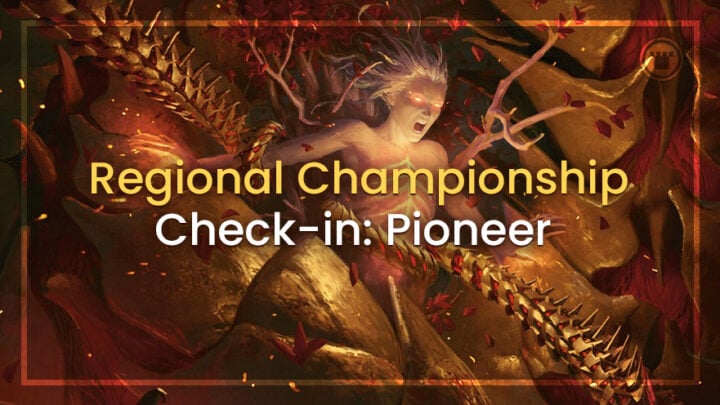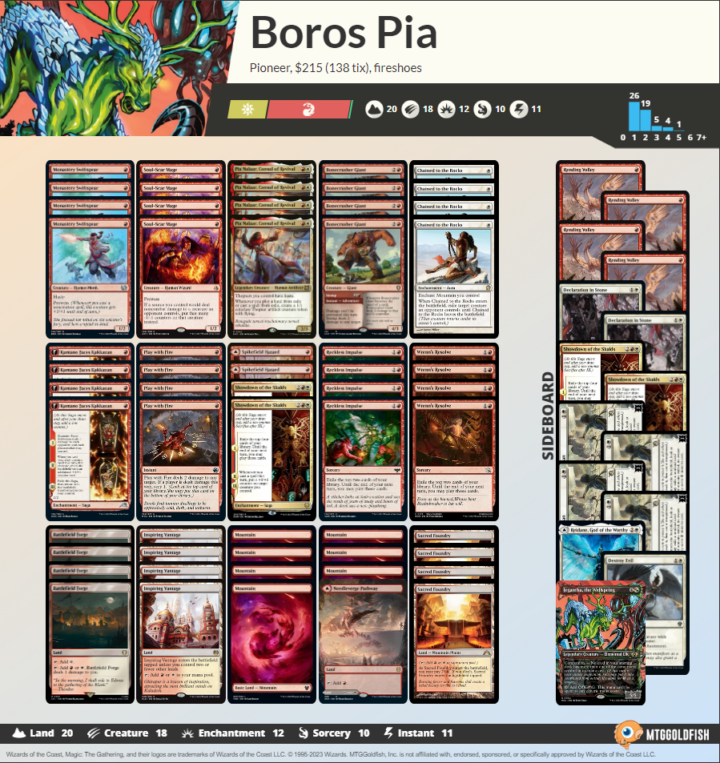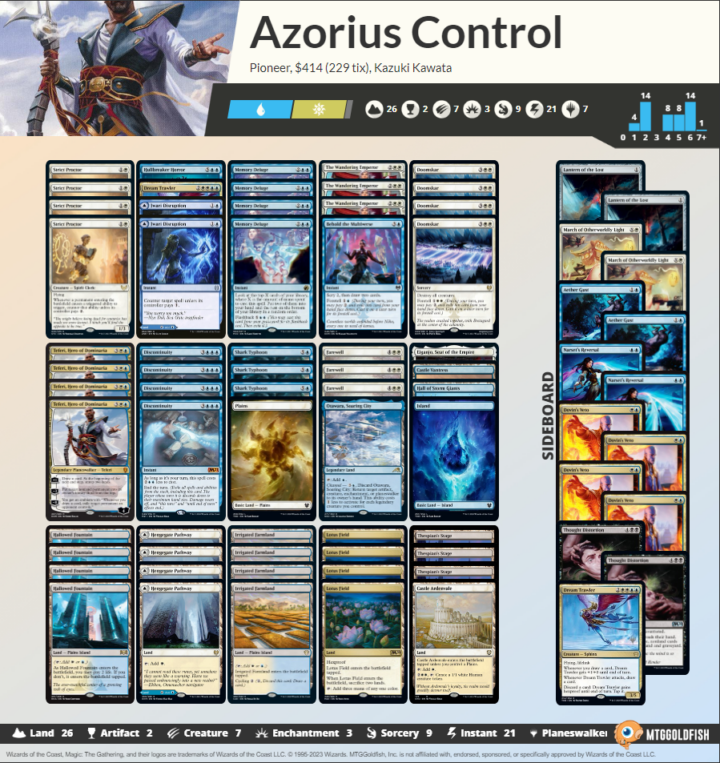With so much to explore in Modern thanks to The Lord of the Rings: Tales of Middle-earth, it has been about a month since I last wrote about Pioneer. In that time, a lot has happened, and there are some Pioneer decks you need to know about that might have an impact on any upcoming Regional Championship Qualifiers.
Boros Pia
This deck is the new hotness in Pioneer from the last couple of weeks. It looks to abuse Pia Nalaar, Consul of Revival along with cards like Wrenn’s Resolve and Showdown of the Skalds to generate a large influx of cards and thopters.
One of the good parts of having all these pseudo draw effects is if you need to find specific cards, your deck can do it much more easily than others. This also means in sideboard games you’re able to find your cards for the matchup more reliably.
This has huge applications in spots where your cards are incredibly high impact. A great example of this could be Rest in Peace versus Phoenix.
While that is the cool part of the deck, this is ultimately just an aggressive list that has the backup option to do what we talked about with Pia. Otherwise this deck can look a lot like Boros Convoke. However, Pia can actually play on the stack by occasionally being the burn deck.
This gets around the issue Boros Convoke has: the difficulty of closing out games when you lose your board. This extra dimension adds reach that makes a real impact, and it’s worth mentioning that the thopters made by Pia are part of this burn element. Think of them like Prowess triggers that stay around.
This deck is much more impressive than it looks at first glance, and I believe it will be a real player in the format going forward (much like I said when Boros Convoke first came on the scene). It’s not that this brew is broken, but it’s going to be at least be a stable part of the metagame
Lotus Field Control
Blue/White Control has been a mainstay of the format since Pioneer’s inception. However, barring small weekend outliers, the deck has a history of horrible win rates. All the same, it has a fervent following and is often one of the most played decks.
This leads us to a new twist that might give this archetype the push it needs. Lotus Blue/White Control looks to abuse Lotus Field with cards like Strict Proctor to negate the drawback of sacrificing lands. Then we use high impact, expensive spells to take over the game.
Now, if Strict Proctor was only good at enabling Lotus Field, this deck would probably be a lot worse. However, this spirit has a lot of utility in multiple match ups by making enter the battlefield triggers cost mana.
For example, it greatly reduces the effectiveness of the following cards:
- Cavalier of Thorns
- Brutal Cathar
- Thalia’s Lieutenant
- Cauldron Familiar
- The entirety of Boros Convoke
The list goes on, to be honest, but I think you get the idea. A 1/3 flier also offers a great, defensive body. So, even in games where you are not drawing Lotus Field, this card still has a decent impact.
And once we have generated so much mana, we can play different type of control game. Gone are the days of leaning on lots of counterspells to control what your opponents are doing. Now we are a much more tap out focused deck.
To start, we’re full of board wipes. From four Doomskar to three Farewells, your opponent is going to have a terrible time sticking creatures on the battlefield.
The deck also gets to play Discontinuity, an incredibly strong spell that normally is way too mana restrictive for competitive play. This card can actually act as a counterspell when cast in response to your opponent casting their own spell, or you can fire it off in your opponent’s upkeep to immediately end their turn.
This deck also features creatures in the main deck to close the game out. Cards like Dream Trawler are incredibly potent at winning the game and rendering racing situations unwinnable for your opponent.
Meanwhile, Hullbreaker Horror is a great way to lock the opponent out once you have the board stabilized. While this list doesn’t have a myriad of counterspells or cheap spells to trigger Horror, you have just enough options to bounce key cards.
Considering all the potential above, this should be the default blue/white control deck in my opinion, barring some huge metagame shift towards combo decks.
Mono Green
Look, we need to have a talk, Magic community. This deck has been the best, tier one performer across all the Regional Championships this season. And I get it. Not only do I dislike playing against this deck, it can be equally unfun to pilot. However, I would be not doing my job. If I didn’t tell you to play this deck anyway.
Mono green has been written about ad nauseum. I even wrote a primer about it almost a year ago (just ignore the Teferi part since that’s not really part of the list anymore. The rest still works). So I’m not going to try and convince you with some new sideboard tech to wish for.
Instead, I’m just going to implore you to realize that Polukranos is one of the best additions to this deck. It has allowed this archetype to play a more consistent beat down game, which means you’re less reliant on the combo while simultaneously forcing opponents to respect it.
If you’ve been lost in Pioneer and you’re just trying to qualify for the RC, learning to master mono green will pay huge dividends. It’s just the best stack there is at the moment.
End step
Pioneer is a deep format where skill expression can help you leverage the deck you decide to play. Despite this, many players often just boil it down to being a high-luck, play/draw format. But once you get past that mentality, there should be options out there from everyone.

Mason Clark is a grinder in every corner of the game who has played at the pro level and on the SCG Tour with Team Nova. Whether he’s competing in Standard, Historic or Modern, Mason plays with one goal in mind: to be a better player than he was the day before. Check out his podcast, Constructed Criticism, and catch his streams on Twitch.




